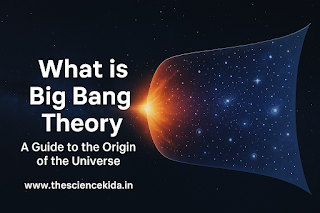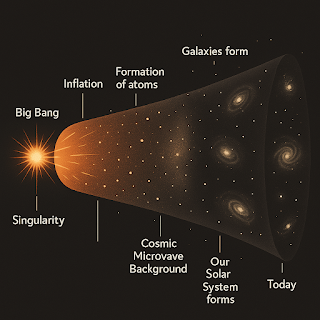Introduction:
Have you ever looked up at the night sky and wondered, "Where did all this come from?" The answer lies in one of the most fascinating scientific theories of all time — the Big Bang Theory. This theory explains how the universe came into existence, how it has evolved, and why it’s still expanding even today.
In this article, we’ll break down the Big Bang Theory in simple terms, share a helpful analogy, present a visual timeline, and highlight the evidence that supports it.
What is the Big Bang Theory?
The Big Bang Theory is the leading scientific explanation for the origin of the universe. It states that the universe began approximately 13.8 billion years ago from an extremely hot, dense point known as a singularity, and has been expanding ever since.
Importantly, the Big Bang wasn’t an explosion in space — it was an expansion of space itself. This ongoing expansion explains why galaxies are moving away from each other even today.
---
Key Stages of the Universe's Evolution
Let’s walk through the major stages that followed the Big Bang:
1. Singularity - All matter and energy were compressed into an incredibly tiny, dense point.
2. The Big Bang - The universe began expanding rapidly.
3. Inflation - Within a fraction of a second, the universe expanded faster than the speed of light.
4. Formation of Basic Particles - Subatomic particles like protons, neutrons, and electrons began to form.
5. Formation of Atoms - Hydrogen and helium atoms formed as the universe cooled.
6. Cosmic Microwave Background Radiation - About 380,000 years later, light was finally able to travel freely through space.
7. Formation of Stars and Galaxies - Gravity pulled matter together to form the first stars and galaxies.
8. Formation of Our Solar System - Around 4.5 billion years ago, our Sun and planets formed.
9. Present Day - The universe continues to expand and evolve.
Simple Analogy: The Expanding Balloon
To better understand the Big Bang, imagine a balloon with dots drawn on it.
As you inflate the balloon, the dots move away from each other, just like galaxies in the universe. This helps us understand that it’s not the galaxies moving through space — it’s space itself that’s expanding.
There’s no center to this expansion — every point in the universe moves away from every other point.
---
Visual Representation
Here’s a simplified timeline illustration of the Big Bang and the expansion of the universe:
This cone-shaped diagram is a powerful way to visualize how the universe has changed over billions of years.
Scientific Evidence Supporting the Big Bang Theory
Several key pieces of evidence support the Big Bang Theory:
1. Cosmic Microwave Background Radiation (CMB):
Detected in 1965, this faint glow is leftover heat from the early universe — a major proof of the Big Bang.
2. Redshift of Galaxies:
Light from distant galaxies appears "redshifted", meaning they’re moving away from us — strong evidence that the universe is expanding.
3. Abundance of Light Elements:
The presence of hydrogen, helium, and lithium in the universe matches what we would expect from the Big Bang model.
---
Frequently Asked Questions (FAQs)
Q: Was there anything before the Big Bang?
A: Scientists don’t yet know what, if anything, existed before the Big Bang. Current physics breaks down at the singularity.
Q: Is the Big Bang just a theory?
A: In science, a “theory” is a well-substantiated explanation. The Big Bang Theory is supported by a lot of observational evidence.
Q: Will the universe keep expanding forever?
A: Current data suggests the expansion is accelerating. The exact fate of the universe is still under study.
---
Conclusion
The Big Bang Theory offers a fascinating glimpse into the birth and evolution of the universe. It’s more than just a theory — it's a powerful scientific model backed by decades of research and observation. Whether you're a student, a science enthusiast, or just a curious mind, understanding this theory helps you appreciate the vastness and mystery of the cosmos.
Enjoyed this article? Share it with your friends or drop a comment below with your thoughts and questions!







0 Comments